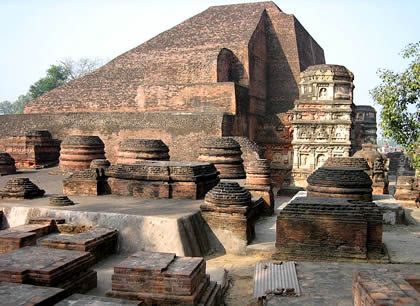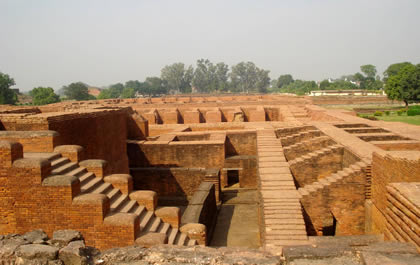World History
Nalanda was the most renowned center of Buddhist learning in India in the fourth–12th centuries. A Buddhist monastic center and major university were located at Nalanda, which is in Baragaon, Bihar state, in east central India, about 90 miles southeast of the state capital of Patna.
The village’s association with Buddhism predates the establishment of the university and monastery: Legend has it that the Gautama Buddha visited the Nalanda village several times and delivered sermons there, and that one of his principal disciples, Sariputta, was born near Nalanda village.
Nalanda University was established in the fifth century and grew, with more than 10,000 students from many different countries attending the university at the time of its destruction in the 12th century.
The Chinese pilgrim and scholar Xuanzang (Hsuan-tsang) studied at Nalanda University in the seventh century and left detailed accounts of it in his writings. Besides Theraveda and Mahayana Buddhism, instruction was offered in medicine, astronomy, and art.
Nalanda, along with many other Buddhist monasteries and temples, was sacked by Turko-Afghan Muslim invaders led by Bakhtiyar Khalji in the 12th century. The monastery and university were destroyed and many of the monks either were killed or fled to other parts of Asia, in particular Nepal and Tibet.
This invasion marked the virtual end of Buddhist culture in India until the 1950s, although Buddhism continued to flourish in other Asian countries such as Tibet, China, Japan, and Southeast Asia. In fact Buddhism in those countries was partly nourished by monks from Nalanda who sought refuge.
Many historians also believe that destruction of Buddhist centers of higher learning at this time caused the abrupt demise of ancient Indian scientific thought in areas such as mathematics and medicine.
The ruins of Nalanda are frequently studied by scholars today because of their central importance in the history of Buddhist history, culture, and art. Currently excavated ruins cover an area of about 150,000 square miles, and it is estimated that this constitutes only 10 percent of the total area that was developed in the 12th century, as described by Xuanzang.
Nalanda is also the name of the administrative district where the ruins are located. The name Nalanda means “the place that confers the lotus†and survives as the name of a Buddhist monastery near Lavaur, France, and two colleges, one in Toronto, and one in Sri Lanka.
- Dvaravati
Dvaravati map The Mon kingdom of Dvaravati (also called Siam) flourished in what is now Thailand from the sixth century c.e. to around the 11th century. The kingdom covered the political area of Nakhon Pathom (west of present-day Bangkok), U-Thong, and...
- Harsha Vardhana - Indian King
Harsha kingdom map Harsha Vardhana was a king of northern India who reunited some of the small city-states that had become independent after the fall of the Gupta dynasty and who used his position to reinvigorate the practice of Buddhism throughout his...
- Shotoku Taishi
Prince Shotoku Taishi Prince Shotoku Taishi was crown prince and regent of Japan between 592 and 622. His rule opened an era of great reforms that advanced Buddhism and Chinese political and cultural influence in Japan. For his role he is called the Great...
- History Of Malaysia
History of Malaysia. This is a brief essay on the history of the Asian nation of Malaysia. The Encyclopædia Britannica notes, "Country of Southeast Asia, composed of two noncontiguous regions: Peninsular, or West, Malaysia on the Malay Peninsula and...
- The Discovery Of New Guinea
The Discovery of New Guinea - Illustrations, facsimile maps and text taken from George Collingridge's book, The First Discovery of Australia and New Guinea. Please note that the book itself is not here. This is merely a collection of some of the...
World History
Nalanda
 |
| Nalanda ruins |
Nalanda was the most renowned center of Buddhist learning in India in the fourth–12th centuries. A Buddhist monastic center and major university were located at Nalanda, which is in Baragaon, Bihar state, in east central India, about 90 miles southeast of the state capital of Patna.
The village’s association with Buddhism predates the establishment of the university and monastery: Legend has it that the Gautama Buddha visited the Nalanda village several times and delivered sermons there, and that one of his principal disciples, Sariputta, was born near Nalanda village.
Nalanda University was established in the fifth century and grew, with more than 10,000 students from many different countries attending the university at the time of its destruction in the 12th century.
  |   |
The Chinese pilgrim and scholar Xuanzang (Hsuan-tsang) studied at Nalanda University in the seventh century and left detailed accounts of it in his writings. Besides Theraveda and Mahayana Buddhism, instruction was offered in medicine, astronomy, and art.
Nalanda, along with many other Buddhist monasteries and temples, was sacked by Turko-Afghan Muslim invaders led by Bakhtiyar Khalji in the 12th century. The monastery and university were destroyed and many of the monks either were killed or fled to other parts of Asia, in particular Nepal and Tibet.
This invasion marked the virtual end of Buddhist culture in India until the 1950s, although Buddhism continued to flourish in other Asian countries such as Tibet, China, Japan, and Southeast Asia. In fact Buddhism in those countries was partly nourished by monks from Nalanda who sought refuge.
 |
| Another view of Nalanda ruins |
Many historians also believe that destruction of Buddhist centers of higher learning at this time caused the abrupt demise of ancient Indian scientific thought in areas such as mathematics and medicine.
The ruins of Nalanda are frequently studied by scholars today because of their central importance in the history of Buddhist history, culture, and art. Currently excavated ruins cover an area of about 150,000 square miles, and it is estimated that this constitutes only 10 percent of the total area that was developed in the 12th century, as described by Xuanzang.
Nalanda is also the name of the administrative district where the ruins are located. The name Nalanda means “the place that confers the lotus†and survives as the name of a Buddhist monastery near Lavaur, France, and two colleges, one in Toronto, and one in Sri Lanka.
- Dvaravati
Dvaravati map The Mon kingdom of Dvaravati (also called Siam) flourished in what is now Thailand from the sixth century c.e. to around the 11th century. The kingdom covered the political area of Nakhon Pathom (west of present-day Bangkok), U-Thong, and...
- Harsha Vardhana - Indian King
Harsha kingdom map Harsha Vardhana was a king of northern India who reunited some of the small city-states that had become independent after the fall of the Gupta dynasty and who used his position to reinvigorate the practice of Buddhism throughout his...
- Shotoku Taishi
Prince Shotoku Taishi Prince Shotoku Taishi was crown prince and regent of Japan between 592 and 622. His rule opened an era of great reforms that advanced Buddhism and Chinese political and cultural influence in Japan. For his role he is called the Great...
- History Of Malaysia
History of Malaysia. This is a brief essay on the history of the Asian nation of Malaysia. The Encyclopædia Britannica notes, "Country of Southeast Asia, composed of two noncontiguous regions: Peninsular, or West, Malaysia on the Malay Peninsula and...
- The Discovery Of New Guinea
The Discovery of New Guinea - Illustrations, facsimile maps and text taken from George Collingridge's book, The First Discovery of Australia and New Guinea. Please note that the book itself is not here. This is merely a collection of some of the...
